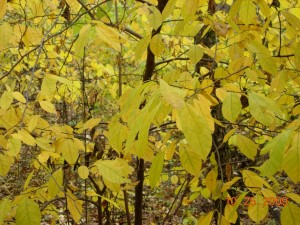
Spicebush, late October, Oshtemo Township, Section 9. Photo by Richard Brewer
Wetlands are scarce in Oshtemo Township. Its thirty-six square miles are mostly high and dry and the soils are mostly well-drained. A few kettles exist in the moraine-outwash plain topoography. These are depressions formed when ice blocks left behind during the retreat of the last Pleistocene ice sheet melted. Most kettles in Oshtemo Township don’t hold water today. A few do some or most years; perhaps a clay lens lies somewhere beneath them, or perhaps enough clay occurred in the surrounding glacial drift to form a more-or-less impermeable layer when it eroded into the kettle.
The kettles that hold water year round or for a few months in the spring tend to have a buttonbush swamp at the bottom; some have a band of spicebush up the bank from the buttonbush. These are features of some of the sites disturbed least by agriculture and other human activity.
A small triangle of swamp forest is still present in the northwest corner of Oshtemo Township, but several wetland vegetation types that occur elsewhere in Kalamazoo County don’t seem to be present here. I’m unaware of any examples of open bog, bog forest, sedge fen, or prairie fen. Possibly small patches of some of these might have been here at the time of settlement.
Early this November I started noticing a good-sized tamarack tree in the wetland at the west edge of the Lilian Anderson Arboretum (Section 15) as I drove by. It was only 10 0r 15 yards south of West Main (M-43). At this time in the fall, tamarack needles turn a gold color, so the species is easily spotted. I finally stopped by on Saturday 14 November, by which time many of the leaves had fallen and the few remaining ones were dull brown.
The situation where the tamarack is growing is consistent with the possibility of fen. The site is at the base of a slope where ground water feeds the sizable wetland northeast of Bonnie Castle Lake. However, I haven’t noticed fen plants at other places along the edge of the wetland on many other visits to the Arboretum. I walked around near the tamarack, but I was just wearing short leather boots and couldn’t get very far out. I didn’t see any obvious fen indicator species, but this isn’t not a good time of year for botanizing anyway. I’ll have another look or two next spring and summer.
I’ll also make a point late next October of driving around the other wetlands in the township to see if more tamaracks are evident. Clarence and Florence Hanes found tamaracks in the Twin Lakes area which is right next door to Oshtemo, but nearly all the Twin Lake low ground is across the line, in Alamo Township.

Spotted wintergreen, mid-November,Oshtemo Township, Section 9. Photo by Richard Brewer.
Walking back up the wooded slope above the wetland at the Arboretum, I saw a few spotted wintergreen plants (also called spotted pipsissewa). It’s a small plant, handsome with dark green leaves with a whitish line running along the midrib. The line is often rather jagged looking where the pale coloration runs off varying distances along the side veins. The leaves are evergreen and were peeking through the fallen oak leaves. A good share of the oak areas in Oshtemo Township that weren’t cleared still have the species, though I’ve never seen it abundant. A plant or two or small patches pretty widely scattered is the way it usually occurs. Its geographic range is basically eastern North America, in most parts of which its occurrence is much the same as here–never common but seemingly not in serious trouble.